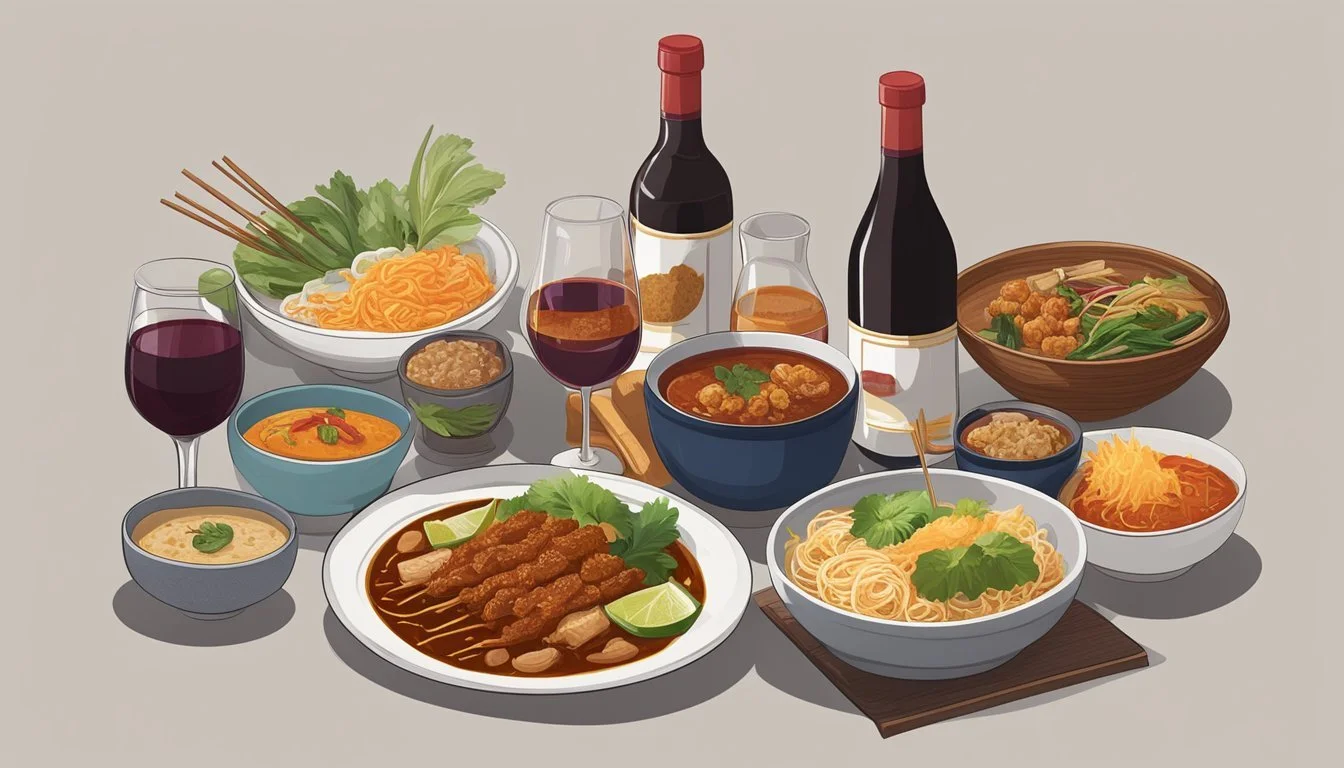What Wine Goes Well with Malaysian Food?
Pairing Tips for a Flavorful Experience
Pairing wine with Malaysian food (What wine goes well with Malaysian food?) involves a delicate balance due to the robust flavors and aromas found in the region's cuisine. Malaysian dishes commonly feature a rich tapestry of spices, heat, and complex flavor profiles, which can present an exciting challenge when choosing an accompanying wine. The key is to complement the dish's intensity and ingredients without overwhelming the palate.
One could consider aromatic white wines like Gewurztraminer to pair with Chicken Rendang, (What wine goes well with chicken rendang?) as the wine's own bouquet of spices and slight sweetness can echo the dish's boldness while offering a refreshing contrast. For dishes with a hint of sweetness or rich, creamy sauces (What wine goes well with creamy sauces?), a slightly oaked Chardonnay could provide the right balance, cutting through the richness while harmonizing with the dish's flavor profile.
Red wine aficionados might reach for a bottle of Syrah or a blend like Cabernet Shiraz when serving robust dishes such as Siew Yoke, where the meat's fatty richness and savory crust can stand up to the wine's tannins and bring out underlying fruit notes. In essence, the choice of wine with Malaysian food should be as thoughtful and nuanced as the cuisine itself, enhancing both the meal and the dining experience.
Malaysian Cuisine Characteristics
Malaysian cuisine offers a symphony of flavors drawing from its multi-ethnic population. It is notable for its use of aromatic spices, coconut milk, and fresh herbs, creating dishes that can be both rich and spicy.
Rendang and Robust Flavors
Rendang is a celebrated dish in Malaysian culture, known for its potent blend of spices such as lemongrass, galangal, and turmeric. This slow-cooked curry-like dish traditionally features beef that becomes tender over hours, allowing the robust flavors to deeply infuse the meat.
Nasi Lemak and Coconut Richness
Nasi Lemak stands out as Malaysia's national dish, where rice is cooked in coconut milk and pandan leaves, imparting a creamy texture and fragrant aroma. This dish is often accompanied by spicy sambal, fried crispy anchovies, (What wine goes well with anchovies?) toasted peanuts, and hard-boiled or fried eggs.
Satay and Grilled Delights
Satay refers to skewered and grilled meats, such as chicken, beef, or lamb, which are marinated with a blend of spices and served with a distinctive peanut sauce. Charcoal-grilling imparts a smoky flavor that complements the spices used in Malaysian satay marinades.
Laksa and Spicy Soups
Laksa, a staple in Malaysian cuisine, varies regionally but invariably includes a spicy soup base. It combines noodles with chicken, shrimp or fish, and is garnished with vegetables and herbs. The broth is rich with coconut milk and spices, delivering a complex and satisfying flavor.
Street Food Staples
Street food in Malaysia is a window into the country's culinary soul, offering a diverse array of choices. Char Kway Teow, stir-fried rice noodles with shrimp, blood cockles, and bean sprouts, is a favorite. The Ramly Burger is a unique Malaysian twist on the burger, and Rojak, a fruit and vegetable salad, is dressed with a pungent shrimp paste and peanut sauce. Each dish reflects the essence of Malaysian street food: fresh, flavorful, and readily available.
Wine Pairing Principles
In the art of pairing wine with Malaysian food, one must consider the body, tannins, and acidity of wines as well as how they interact with the complexity of flavors and varying levels of heat in the dishes.
Understanding Body and Tannins
Body refers to the weight or fullness of a wine as it is perceived in the mouth. Full-bodied wines, such as Syrah, often stand up well to rich, hearty dishes like beef rendang (What wine goes well with beef rendang?), due to their robust structure and higher levels of tannins. These are compounds that can add astringency and complexity, balancing the richness of the food.
Full-bodied reds: ideal for rich and flavorful beef or lamb dishes
Medium-bodied reds: suitable for lighter meats or more subtly flavored dishes
Balancing Acidity and Sweetness
Acidity in wine can refresh the palate, especially when paired with oily or fatty dishes (What wine goes well with fatty dishes?), like Wong Mei Kee Siew Yoke (roasted pork belly (What wine goes well with pork belly?) ). Wines with a hint of sweetness, such as Gewurztraminer, can complement the spice-forward profiles common in Malaysian cuisine, by offsetting heat and elevating intrinsic sweet and sour components in the food.
High-acid wines: pair with fatty or rich foods
Off-dry wines: pair with spicy or sweet and sour dishes (What wine goes well with sweet and sour dishes?)
Heat and Spice Considerations
The heat and spice of Malaysian dishes necessitate careful consideration. A wine with less alcohol and a slight sweetness can alleviate the burn of spices rather than exacerbating it. For example, a lightly oaked Chardonnay can have a cooling effect on the palate, making it a match for spicy sambals or curries.
Off-dry whites: counterbalance the heat in spicy dishes (What wine goes well with spicy dishes?)
Low-to-medium alcohol content: prevent intensifying the dish's heat
By recognizing the importance of these principles, aficionados can elevate their dining experience. Sommeliers often apply these rules to curate the perfect food and wine pairings, ensuring that neither the wine nor the Malaysian delicacies it accompanies overpower each other.
White Wine Selections
In the realm of Malaysian cuisine, which is known for its robust flavors and intense spices, selecting the right white wine is crucial. These wines should complement the complex taste profiles of Malaysian dishes without overpowering them.
Riesling and Asian Cuisine
German Riesling, with its bright acidity and sweet flavor profile, pairs excellently with Malaysian food. The wine's sweetness balances the heat from dishes like spicy laksa, and its citrus notes can enhance the lemongrass commonly used in Malaysian cooking.
Sweetness: Balances spice
Acidity: Cuts through richness
Chardonnay Versatility
Chardonnay comes in two styles: oaked and unoaked. Oaked Chardonnay, with its buttery notes, pairs well with cream-based Malaysian curries, while unoaked Chardonnay, which is fresher and cleaner, compliments dishes seasoned with Asian spices.
Unoaked: Pairs with Asian spices
Oaked: Complements creamier dishes
Sauvignon Blanc Pairings
Sauvignon Blanc's zesty and crisp character marries well with Malaysian green mango salads and dishes with a tangy flavor profile. It has a refreshing quality that provides a palate-cleansing effect between bites.
Zesty: Enhances tangy flavors
Crisp: Offers a palate cleanse
Sparkling Wines for Celebration
Sparkling wines, such as Moscato and Prosecco, with their effervescence and touch of sweetness, are a festive complement to Malaysian desserts. They can also cut through the richness of dishes with coconut milk, making them a versatile choice for an array of Malaysian treats.
Effervescence: Lightens rich dishes (What wine goes well with rich dishes?)
Sweetness: Complements Malaysian desserts
Red Wine Pairings
Pairing red wine with Malaysian food is an art that enhances the flavorful dishes with complementary vintages. Each red wine variety can unlock different nuances in Malaysian cuisine.
Shiraz and Rich Meat Dishes
Shiraz, also known as Syrah, is a bold red wine that matches well with hearty meat dishes like Beef Rendang. The peppery notes and berry flavors of Australian Shiraz/Cabernet Sauvignon blend complement the complexity and robust spice blend commonly found in this Malaysian delicacy.
Merlot for Milder Flavors
Merlot is a versatile red wine, with a softer profile that pairs well with milder Malaysian flavors. Dishes that are not heavily spiced, perhaps featuring subtle savory notes, can be enhanced with a glass of Merlot or a Merlot/Cabernet Sauvignon blend, where the fruitiness of the Merlot grape brings out the dish's inherent flavors.
Cabernet Sauvignon and Spice
Cabernet Sauvignon is known for its capacity to stand up to more intense flavors. Its boldness can complement a spiced Malaysian dish, where its tannins can balance the heat and aromatics efficiently, without overpowering the experience.
Trendy Red Wine Varieties
Exploring less traditional varieties, the Gamay grape of the French Beaujolais provides a lighter red wine option, which can be a refreshing counterpoint to spice-laden dishes. Pinotage, with its smoky and earthy undertones, might suit smoky barbecue-inspired Malaysian plates.
Rosé and Lighter Fare
Rosé wine, with its refreshing acidity and fruit-forward profile, complements a variety of Malaysian dishes. Its versatility particularly shines when paired with lighter fare such as seafood and salads, enhancing the delicate flavors without overpowering them.
Rosé with Seafood and Salads
When selecting a Rosé for Malaysian seafood dishes, it's important to consider the preparation and seasoning of the seafood. Grilled fish, with its smoky char, harmonizes well with a Rosé that has a hint of minerality. The crispness of the wine cuts through the richness of the grilled fish, balancing the overall taste experience.
Fish: Opt for a dry Rosé to complement the flavors of the fish without adding extra sweetness.
Prawn Dumplings: These dumplings, often served with subtle yet flavorful dips, demand a wine that can handle an array of tastes. A Rosé with notes of red berries and a zesty finish will elevate the prawn's sweet, tender profile.
Salads featuring bold Malaysian spices and herbs are prime candidates for Rosé pairings. The light, fruity essence of the wine pairs nicely with fresh greens and tangy dressings, providing a palate-cleansing effect.
Salad Pairings:
Spicy Salads: Choose a Rosé with a robust fruit character to counterbalance the heat.
Herbaceous Salads: An aromatic Rosé complements the fresh herbs without competing for attention.
To maximize the enjoyment of Rosé with Malaysian lighter fare, consider serving the wine well-chilled. This temperature accentuates the wine's refreshing qualities and makes it an even more delightful companion to the vibrant flavors of Malaysian cuisine.
Global Wine Influences
As Malaysian cuisine gains international acclaim, pairing its complex flavors with global wines has become a culinary adventure. The interplay between food and wine showcases the diverse expressions of vineyards worldwide.
Discovering New World Wines
New World wines, from countries like Australia, New Zealand, South Africa, Argentina, and Chile, are notable for their fruit-forward and innovative wine-making techniques. A bold Australian Shiraz from regions such as South Australia is often praised for its ability to complement Malaysian dishes rich in spices and umami flavors. The ripe red fruits with a hint of spice provide a harmonious balance to the aromatic and multi-layered profiles of Malaysian curries and grilled meats.
Chile, celebrated for its signature black grape, Carménère, produces wines with notes of spice and dark fruits, which can successfully stand up to the powerful tastes found in Malaysian cuisine.
New Zealand is renowned for its vibrant Sauvignon Blancs that offer a refreshing contrast to the heat and intensity of Malaysian dishes, such as those with a citrus or tamarind base.
Exploring Old World Traditions
Conversely, Old World wines are steeped in tradition and often come from countries with long-established wine-making practices, including France, Spain, and Austria. The wines from these regions possess an innate elegance and structure that can elevate Malaysian culinary experiences.
Burgundy produces prestigious Chardonnays that pair beautifully with subtler Malaysian dishes, like steamed fish or dim sum. These wines proffer a lightly oaked touch that does not overwhelm the delicate flavors.
In contrast, a French Bordeaux Blanc reveals the capability of white wines to interact gracefully with the intricate spice blends in Malaysian fare.
Spanish wines, which may include grapes like Tempranillo and Garnacha, are frequently aged in oak, offering a robust profile of red fruits and spices that proves to be a favorable match for heartier Malaysian plates.
Region Wine Type Malaysian Dish Recommendation South Australia Australian Shiraz Grilled Meats, Spicy Curries Chile Carménère Rich Beef Stews, (What wine goes well with beef stew?) Flavorful Stir-fries New Zealand Sauvignon Blanc Citrus-based Dishes, Tamarind-infused Fare Burgundy Chardonnay (lightly oaked) Steamed Fish, Dim Sum Bordeaux Bordeaux Blanc Spiced Poultry, Aromatic Salads Spain Tempranillo Blends Hearty Stews, Grilled Meats
Wines from both New and Old World regions offer a delightful array of choices to enhance the experience of Malaysian cuisine. Whether through boldness or subtlety, the global influence in wine pairing enhances each dining encounter.
Perfecting Food and Wine Pairing
Pairing Malaysian cuisine with the right wine enhances the dining experience by highlighting the flavors and aromas of both the food and the beverage. This section navigates through cultural nuances, expert advice, and established rules to master the art of food and wine pairing.
Cultural Considerations
Malaysian food represents a confluence of flavors from various Asian cuisines, including Indian curries and Chinese food. (What wine goes well with Chinese food?) These dishes often feature bold spices and coconut milk, influencing the selection of wine. For instance, a spicy Chicken Rendang pairs beautifully with a Gewürztraminer, whose floral notes complement the dish's complexity.
In choosing wine for beef dishes like beef satay (What wine goes well with beef satay?), a Syrah with its peppery undertone could match the smokiness and spices. Seafood, ubiquitous in Malaysian cuisine, requires wines that balance the delicateness of the flavors. A crisp Chardonnay might pair adequately with a spicy Szechuan sauce, cutting through the heat and enhancing the dish.
The Role of a Sommelier
A sommelier is a knowledgeable wine professional who specializes in all aspects of wine service, including wine pairing. They understand the intricate profiles of both food and wine and can navigate the pairing process effectively.
Their expertise extends to Asian cuisines, where they might recommend a Penfolds Bin 389 Cabernet Shiraz with Malaysian roasted pork belly, to complement the lively palate and vibrant fruits of the dish. Soliciting the advice of a sommelier can transform a meal into a more memorable experience.
Wine Pairing Rules
When pairing wine with Malaysian food, a diner should consider certain rules:
Body:
Light dishes (What wine goes well with light dishes?) pair with light-bodied wines
Rich dishes require full-bodied wines
Acidity:
Acidic wines can balance spicy and rich dishes
Residual Sugar:
Sweeter wines offset the heat from spicy dishes
Tannin Levels (for red wine):
High tannin wines are better with fatty dishes, as tannins cut through the richness
A structured approach, bearing in mind these rules, helps in accentuating the joys of Asian cuisine when accompanied by a suitable wine.
Additional Pairing Tips and Tricks
When considering wine pairings with Malaysian food, one must not overlook the harmony of desserts with sweet wines and the compatibility of cheeses, as well as appropriate choices for festive occasions.
Dessert and Sweet Wine Harmony
To complement the sweet and often pungent flavors found in Malaysian desserts, a Moscato with its fruity character is an exceptional match, especially when desserts feature pineapple or melon. The sweetness and slight fizz help balance the desserts' richness. For heavier desserts featuring durian, an equally bold sweet wine, such as a late harvest variety, may stand up better to the strong flavors.
Cheese and Wine Compatibility
Cheese plays a less traditional role in Malaysian cuisine, but for fusion dishes or cheese platters, intense flavors like those found in mushroom-infused or butter-laden dishes pair well with a full-bodied Chardonnay. Its creamy texture and often subtle oak influences can enhance the umami flavors present in these cheese-based preparations.
Pairing for Festive Occasions
During festive occasions, Champagne or other sparkling wines are often a celebratory staple. They cut through the richness of festive foods and cleanse the palate between bites. For a Malaysian feast, opt for a sparkling wine with a fruity character to counterbalance the spices and aromatic herbs typically found in the celebratory dishes.









